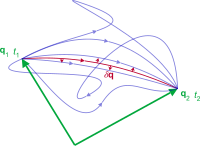Hamilton's principle

Hamilton's principle is a fancy way to describe how things move, like cars or planets or anything else that moves. Imagine you have a toy car that you want to move from one place to another. If you want to do this, you have to push it, right? But how do you know the best way to push it? That's where Hamilton's principle comes in.
Hamilton's principle says that you can find the best way to move something by figuring out the path that will take the least amount of energy. Think about it like this: if you're running a race, you want to take the shortest route possible, right? Because that will be the fastest and require the least amount of energy.
When it comes to moving things, we talk about something called the "action." This is just a fancy math term that describes the thing we want to minimize (or make as small as possible). The action is made up of two parts: the kinetic energy, which is the energy of movement, and the potential energy, which is the energy that something has because of its position.
So, when you want to move your toy car, you have to use some energy to push it. That energy comes from the kinetic energy in your muscles. But at the same time, the car has potential energy because of where it is in space. If you're trying to move it uphill, for example, it will have more potential energy than if you're pushing it on a flat surface.
Hamilton's principle tells us that we can find the best way to move the car by figuring out how to use the least amount of energy overall. This means figuring out the best path to take, and the force needed to push the car along that path. By doing this, we can make the car move in the most efficient way possible.
Overall, Hamilton's principle is just a way to figure out the best way to move things by minimizing the energy needed. It's a handy tool that scientists and engineers use to figure out how things move in the world around us.
Hamilton's principle says that you can find the best way to move something by figuring out the path that will take the least amount of energy. Think about it like this: if you're running a race, you want to take the shortest route possible, right? Because that will be the fastest and require the least amount of energy.
When it comes to moving things, we talk about something called the "action." This is just a fancy math term that describes the thing we want to minimize (or make as small as possible). The action is made up of two parts: the kinetic energy, which is the energy of movement, and the potential energy, which is the energy that something has because of its position.
So, when you want to move your toy car, you have to use some energy to push it. That energy comes from the kinetic energy in your muscles. But at the same time, the car has potential energy because of where it is in space. If you're trying to move it uphill, for example, it will have more potential energy than if you're pushing it on a flat surface.
Hamilton's principle tells us that we can find the best way to move the car by figuring out how to use the least amount of energy overall. This means figuring out the best path to take, and the force needed to push the car along that path. By doing this, we can make the car move in the most efficient way possible.
Overall, Hamilton's principle is just a way to figure out the best way to move things by minimizing the energy needed. It's a handy tool that scientists and engineers use to figure out how things move in the world around us.
Related topics others have asked about:
